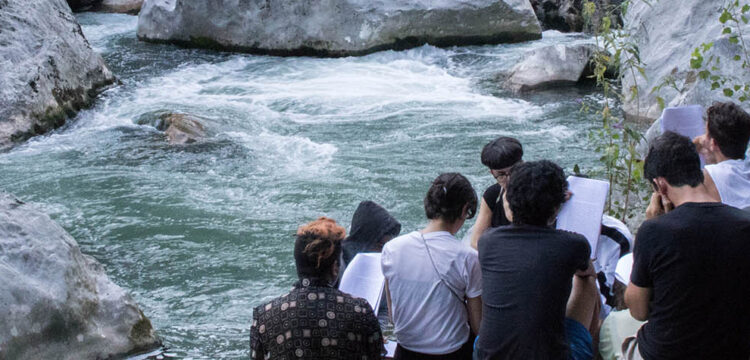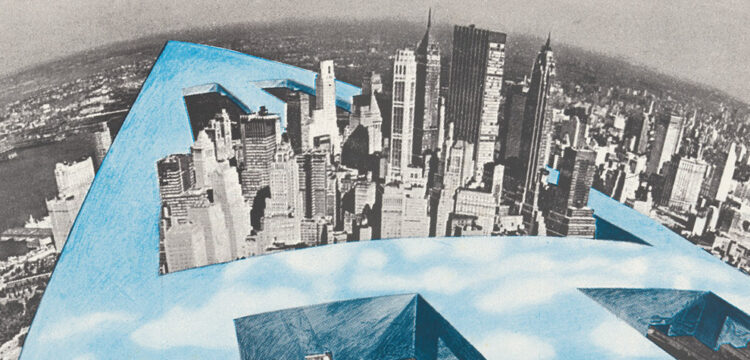Space as Care
The artist residency between the white cube and the black box
In Rome, Il Mattatoio is currently hosting Prender-si Cura (to take care) a residency program for artistic research and production, conceived and curated by Ilaria Mancia, in the spaces of La Pelanda. The residency is welcoming practitioners who are using different languages, such as performance, video, music, theatre, dance and visual arts, within an expanded idea of “performativity” between the white cube and the black box. The experiences of the residencies are collected in a digital diary, in forms of dialogues between Ilaria Mancia and Paola Granato and the residents. The following conversation functions as a diary of the diary, where the two curators share their impressions of the first year.
The artists in residency this year are Alessandro Sciarroni, Riccardo Fazi e Matteo Nucci, BRUTAL CASUAL MAGAZINE (Lady Maru e Jacopo Benassi), Gianmaria Borzillo, Roberto Fassone, Giulia Crispiani, Valentina Furian, Aurelio Di Virgilio, Silvia Calderoni and Ilenia Caleo, ZAPRUDERfilmmakersgroup, MP5, Marina Donatone, Simone Pappalardo, Sara Leghissa, Annamaria Ajmone.
Paola Granato: I’d like to recall the very beginning, as it was the first time for this space to welcome a residency program.
Ilaria Mancia: I started working at Mattatoio in 2019 and by 2020 I was already developing some ideas that could merge a public program with an educational one—the PACS Master’s program which started in January 2020. Then the pandemic and the lockdown created a stasis, and out of this stasis came a rethinking of the possibilities related to this place. Due to its multifunctionality, its potential uses could be diverse. This residency program was born right at that moment, out of a series of dialogues, informal conversations with the artists and the desire, which has always been there, to include within the project the idea of supporting research and artistic production. It wasn’t a foregone conclusion to pursue this path, since this place is subordinate to a public institution, and therefore its spaces are generally closed to live shows; however, we wanted to overturn and “open up” the very idea of the museum, of the institution, by thinking through new productive possibilities freed from future events and exhibitions. The idea was, and still is, to create a place imbued with the artists’ research and experimentation related to performing arts and to the different languages of visual and scenic arts.
We didn’t want to just provide the artist with a studio in which to produce their work, but also to offer a diversified space according to the needs of each specific research. Since performance is an “expanded” concept, we wanted to develop a broad and diversified idea of an artist’s “studio.” The next step was to make our idea a viable proposal that could be implemented as soon as possible. Obviously, during the first lockdown, we needed time to process it, to propose it, and to get to perform it in the rooms, looking for an alternative to the proliferation of online projects.
It all started, as I said, from some conversations between the two of us and the artists involved.
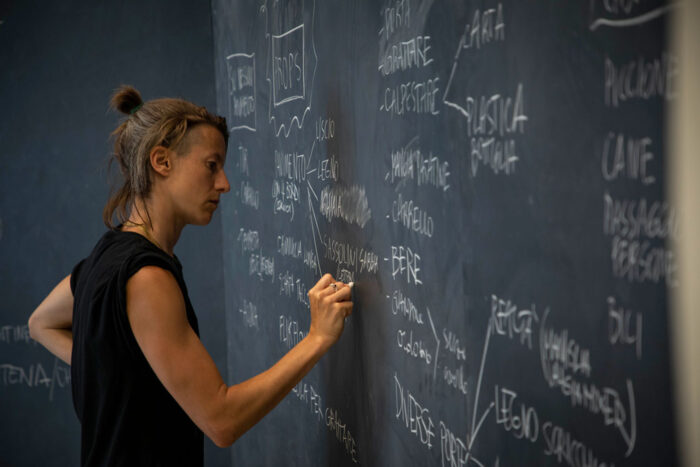
Photo credits Monkeys Video Lab e Azienda Speciale Palaexpo.
Paola: I remember that after one of those video meetings filled with people, you, me, and Sara Leghissa—who was a resident in 2020 and will be back in June of this year—expressed a desire for an exchange that went beyond a conversation about the present, but rather focused on artistic research and the inherent change that was coming along.
Once we began the remote dialogue with the artists, it became increasingly obvious that we all wanted them to be here. On the one hand, those conversations were in themselves an escape from being locked in our houses; on the other, there was a concrete desire, to come and see how this space breathed, which can change so much depending on who crosses it and how it’s activated by research and experimentation.
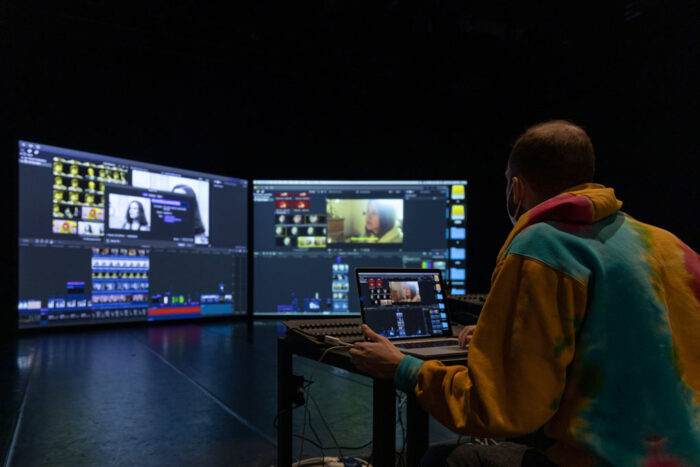
Ilaria: In fact, if you remember, we always used the conditional tense, even while chatting with the artists; it was the tense that accompanied us when they talked to us about different needs and moods, both regarding themselves and how they privately lived those moments of lockdown, and regarding the work.
We kept asking ourselves if it would have been possible to return living the space in presence; while, at the same time, it felt like opening the possibility of a different concept of residency;—as if the residency had already begun, remotely, at the moment in which we asked ourselves common questions and analyzed the state of our respective researches.
Paola: It’s true because it allowed us to reflect on some issues, even very specific ones; everyone presented us with a proposal, a work, some in a fairly advanced state, but all of them filled us with tension. A tension that I felt was active right from the start.
Ilaria: The conditional leaning into the future.
Paola: This year is very different, though.
Ilaria: This year is different, indeed. A new course of residencies started, already in December with Alessandro Sciarroni, who expressed the desire (anticipating ours) to work on the initial phase of a new project. So, we found ourselves here even before having established a dialogue and we were immediately introduced to the material of his new research. As you said before, it’s very important to work while being physically here, to experience what happens in the rooms, and to have this long, common breath with the artists.
Paola: For me, it’s crucial. I risk being a bit sentimental, but knowing that something is happening there, makes you feel involved. My presence also depends on the artists’ needs but, in any case, co-presence is fundamental, it creates a mutual influence; writing while hearing the echo of somebody else’s work, the music moves the air, as a presence in space…
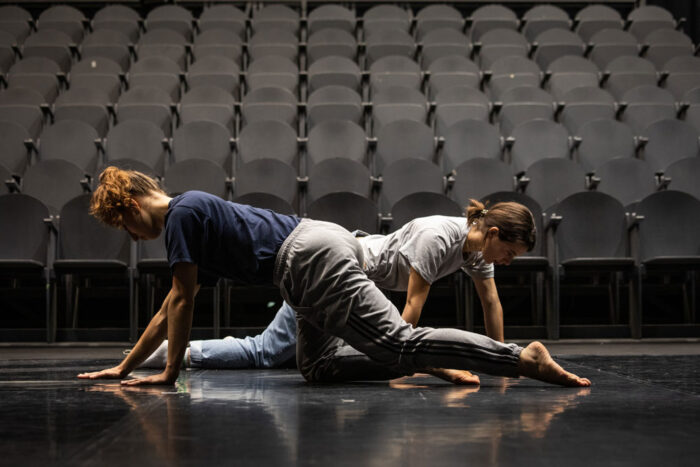
Photo credits Monkeys Video Lab e Azienda Speciale Palaexpo.
Ilaria: Besides, this being inside things, these dialogues, this exchange with the works or with in-presence researches, stimulates the idea (that was already born then and which we hope to pursue and investigate further), of the concept of “collective care”—of being present in relation to the research, in different forms, perhaps not interchangeable, but intertwined. This was the challenge the name of the project sparked from, and we chose it instinctively, in order to underline the common path we had undertaken in uncertain and unforeseen times, however aware of the complex meaning of the word “care” in relation to artistic research and to the present moment. It’s fundamental to keep on questioning this title, to grant ourselves the time to share movements, criticalities, reflections, different materials, in a tension that takes on the “infinite present” and the italian translation of the reflexive form prendersi, “taking care of oneself.” A curator once told me that care is done but never declared. Instead, we declare it, emphasizing its relational aspect, in which we do take care, inasmuch as the artists and the space do—as well as the research that crosses this space. I must admit, however, that I felt called into question, and even challenged, by this statement. I think it should be for us a further spur of analysis.
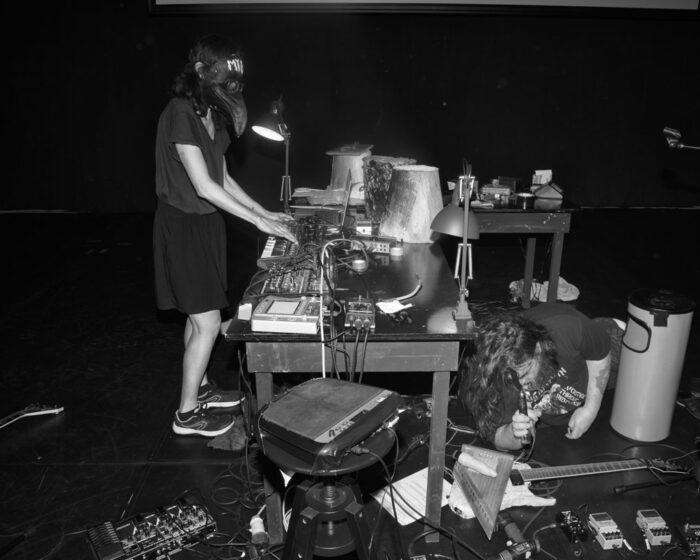
Paola: The name is demanding indeed, because by declaring it the challenge becomes explicit. It’s a name that, starting from a concept such as that of care (which is very relevant at the moment), through the experience of being together that we are currently experiencing—and I’m not only talking about being together in the artists’ research, but also about being together in the office and in writing—thinking together, commenting together… I think it strengthens the concept itself.
Our ides is a way of caring that, as you said, intervenes on the gesture of curatorship and expands it. We want to shift the working process. Last year the dialogue took place before the residency and, in some ways, was even more complex, because you had to carry it out without having a concrete basis. Now it’s it’s the other way around—the dialogue takes place after the residency period has passed, and I find this temporal shift very interesting.
Ilaria: I am pleasantly surprised by the shared desire to keep in touch once the days of work here are over, to continue an epistolary relationship to deepen the experience, maintaining the connection with the artistic works in their development following the residency; the artists we have chosen, in fact, in some cases question the very idea of performance, in others expand it, even regarding the space in which the research happens or is situated. It takes time to understand what happens and to realize how being here has informed on various levels the work in its making or posed unexpected questions in relation to its fruition.
For instance, Roberto Fassone and Valentina Furian are two artists who have developed two video works here. From two different points of view, they raised the issue of how an installation or a video work can question the concept of performance, compared to how we usually perceive it. Can a video be perceived as a choreography? Can the set that comes to life during filming be observed as a performative moment? These were questions that we asked ourselves with them and that will be interesting to investigate further through a remote exchange. More and more, thanks to the artists involved, it is becoming clear that there is no precise distinction between a purely theatrical work and a work that comes from visual art; that the mixing of languages is real, and that is often challenging, both for the artists and for us watching, to define the specificity of the work or, on the contrary, its more ambivalent characteristics.
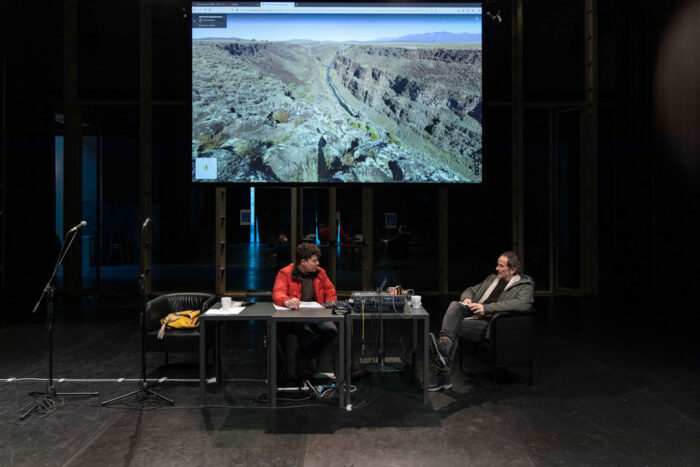
Photo credits Monkeys Video Lab e Azienda Speciale Palaexpo.
Paola: Actually, we are also taken care of by those who arrive, I always feel “cared for,” and it’s never taken for granted. Every arrival, every crossing has its own story. I also think about the conversations, both those we use for the diary but also those more relevant to the productive side or to what will be developed during the residency period.
Ilaria: Even one of the questions we repeatedly asked was “what do you need?”—which comes from the exchange and analysis of the needs related to the different research phases; but also from real needs for technical or economic support to carry on the production, or to involve collaborators, and finally to balance all the parties involved. In my opinion, this is a very important aspect, which connects us, as you said, even more with the making-of and thus with the projection of the work toward the future; in this way, even the creation becomes partly shared.
Paola: That declaring-instead-of-doing that you mentioned earlier puts me in a tough spot, too. Regarding the act of writing, it’s hard to position yourself, if you think you’re acting as an intermediary. It’s inevitable, when you’re writing something, to think about who you’re writing for and therefore who’s going to read it; you have to find an effective way of telling, of archiving a present that’s happening now and that changes every day; even if you find strategies (for example, you can crystallize the aspects that interest us most by recording conversations), it’s something that leaves physical traces on you: seeing the work, seeing the researches in their making, and seeing all of this several times. It’s difficult to communicate this accumulation.
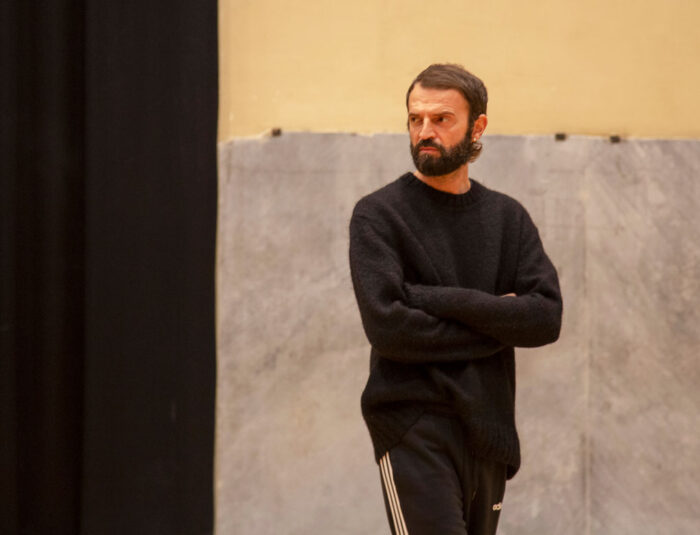
Ilaria: It’s very delicate because in the Diary—the in-depth study, available online, that we decided to dedicate to the residency project and that is made of conversations with the artists, notes, letters, and various materials—we revealed a trace, a story of something that usually does not reach the public for many reasons related to the production phase, including confidentiality. Stepping into this, bringing things to the surface and making them public is a gesture that must be done with respect and complicity, since emotional states, ideas, and hidden intuitions are involved and brought to the surface. This aspect reminds me that we have declared from the beginning the complete freedom of creation from productive constraints. There is no constraint that forces the works we support to be scheduled into a specific program or exhibition, but the more we go on, the more we create ongoing relationships with the artist and, in some cases, the desire emerges to continue this shared path, even after the residency, until the public presentation of the research.
And so, once again, a desire for collective care with the artist may emerges, a desire to understand if certain contexts could be the right ones for a presentation to the public; some of the works developed here could, at the right moment and following a common desire, be scheduled at the Mattatoio. Partly, this has already happened with Luigi Presicce’s video, which we produced for the current exhibition, or with Rä di Martino’s work, which is currently part of one of the exhibition projects at Macro.
Paola: And then there’s also some sort of attachment. With every departure, there’s the sorrow of saying goodbye and every presence leaves its reverberation in space. Some things strike me—I imagine you too—and I would like to share them with as many people as possible, especially right now, with an audience.
Ilaria: At the same time, the path leading to an open vision of collaboration and co-production with other institutions remains central, to be pursued together with colleagues and friends working in other realities. It’s nice to think that the works are traveling and that the field of this collective care between artists and curators can be widened more and more.
Paola: I agree and I want to quote the sentence you always repeat—“where a work feels at its best is where it needs to go.”
Ilaria: Yes, even regarding the various contexts, museums or theaters, there is a curiosity to see who is ready to welcome or question this concept of “care” with us.
Paola: What about the choice of the projects?
Ilaria: In the choice of this edition’s projects, some artists already present last year were invited again. Because it was interesting to develop with them the initial phase of the research, and we asked them to come back to share the closing phase of the creation and thus have an overall, extended vision, of the entire path.
The choice is also oriented by the effort to understand who really needs to be supported right now; those who don’t have either a space or a time to develop their own research. There is also the attempt to cross different generations, regardless of age. And then, as we were saying before, there is an attention to those works that, concerning the issue of performance, represent a place of encounter of both practices and languages, and perhaps a place of deconstruction of areas of belonging. It seems to me that we gave a lot of space to those works that we thought had a potential of rupture, expansion, exchange of possibilities, and encounter of languages. Perhaps, an unknown potential…




